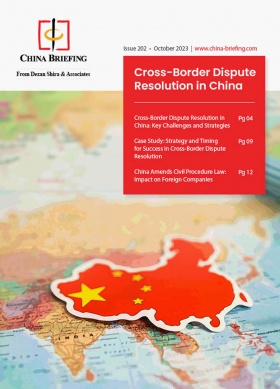China to Issue RMB 1 Trillion in Special Treasury Bonds to Local Governments in Q4 2023 and Q1 2024
On October 24, China’s central government confirmed that it will issue an additional RMB 1 trillion (approx. US$137.4 billion) worth of special treasury bonds (STBs) in the final quarter of 2023. The China treasury bonds, which will be issued to local governments through transfer payments, will help with post-disaster recovery and reconstruction following a summer of severe natural disasters in several areas of the country.
The bond issuance was approved by the Sixth Session of the Standing Committee of the 14th National People’s Congress (NPC), which voted to adopt the resolution approving the State Council’s issuance of additional STBs and the 2023 central budget adjustment plan.
Shi Yinghua, a researcher at the Chinese Academy for Financial Sciences stated in a media Q&A that the funds will be used for both short-term disaster relief and long-term improvement of disaster prevention and resilience.
An official at the Ministry of Finance (MOF) stated that the STBs will be issued “in a timely manner”, and that the MOF has made adjustments to the fourth-quarter national debt issuance plan to create space for additional bond issuance.
Disaster recovery and reconstruction
The additional funds are meant to support local governments with post-disaster recovery and reconstruction, make up for shortcomings in disaster prevention, reduction, and relief, and improve China’s resilience against natural disasters. This decision comes after several areas of China experienced natural disasters over the last few years, including heavy flooding in Beijing, Hebei, and the northeast, Shaanxi and other northern provinces, and several areas of southern China in the summer and fall of 2023.
Natural disasters are becoming a more common phenomenon in China, a fact that is troubling the country’s leadership and policymakers. On August 17, the Standing Committee of the Political Bureau of the CPC Central Committee held a meeting “to study and deploy flood prevention, flood relief, and post-disaster recovery and reconstruction work”. The outcome of the meeting was to “accelerate recovery and reconstruction” and “further enhance China’s disaster prevention, reduction, and relief capabilities.”
An MOF official said that although the budget set at the beginning of the year had included funds for disaster relief and prevention work, it was not enough to meet the funds needed to improve local disaster prevention, reduction, and relief capabilities.
The additional bonds will be issued in two batches, with RMB 500 billion (US$68.7 billion) in the fourth quarter of 2023 and the other RMB 500 billion carried forward to be used in early 2024.
The Ministry of Finance (MOF) stated that the funds will be used in eight major areas:
- Post-disaster recovery and reconstruction;
- Key flood control projects;
- Natural disaster emergency response capability improvement projects;
- Other key flood control projects;
- Irrigation area construction and renovation and key soil and water loss control projects;
- Action to improve urban drainage and flood prevention capabilities;
- Comprehensive prevention and control system construction projects for major natural disasters; and
- High-standard farmland construction in Northeast China and disaster-stricken areas in the Beijing-Tianjin-Hebei region.
As a result of the additional STBs, the national fiscal deficit will increase from RMB 3.88 trillion (US$532.9 billion) to RMB 4.88 trillion (US$670.2 billion), while the deficit rate is expected to increase from 3 percent to about 3.8 percent of GDP.
Is this stimulus?
There are growing expectations that the central government will approve a stimulus package to boost China’s post-pandemic recovery. Despite suggestions that stimulus will be rolled out, no package has yet been announced.
While the issuance of additional STBs will offer a significant funding boost for local governments – and thereby help grow the local economy – central government officials have been clear that the funds are meant to help with disaster relief and prevention and therefore are not direct stimulus.
As the Director of the Department of Finance at the School of Economics at Peking University Liu Yi explained in a media Q&A, local governments are currently under pressure to resolve local government debt risks and ensure expenditure for basic welfare, wages, and operations. This means there is little room for local governments to significantly increase funding for these types of projects through their own financial resources.
She also added that the issuance of STBs will “help drive domestic demand and further consolidate the economic recovery”.
At the same time, the additional bond issuance may be a pragmatic move to maintain steady infrastructure investment in the final quarter of the year, as local governments run out of another key financing tool, special-purpose bonds (SPBs). SPBs are one of the main ways that the central government provides funds to local governments to bankroll major infrastructure projects. Infrastructure investment has been a key driver of China’s economic boom over the last four decades and continues to be an important mechanism for driving post-pandemic recovery.
In March 2023, the government set an annual quota of RMB 3.8 trillion (approx. US$549.2 billion) for its local government SPBs. Local governments were required to issue all of their SPB quotas by the end of September 2023 and invest all of the funds raised into projects by the end of October 2023. This means funding for further investment through the end of the year will have dried up. The issuance of these additional STBs is therefore also another mechanism for the central government to transfer funds to local governments, thereby ensuring that infrastructure investment maintains momentum through the end of the year.
What is the difference between STBs and SPBs?
STBs are one of four types of treasury bonds that China’s central government issues, the other three being ordinary treasury bonds, directional treasury bonds, and SPBs.
STBs are treasury bonds issued for national strategic purposes, while SPBs are generally used to fund major development projects, in particular infrastructure. Although STBs are government debt, they don’t need to be included in local government budgets, and they therefore don’t need to arrange funds for principal and interest payments through the budget.
SPBs, meanwhile, are included in the government budget. They are similar to general bonds, in that they are a financing method for local governments except that they can only be used for specific purposes or repayment, and principal and interest must be repaid through government fund income and special income (such as income from public service fees).
STBs are a rarely used financing tool. The central government has only issued STBs three times in the past in response to unusual circumstances: RMB 270 billion was issued to the four major state-owned banks following the Asian Financial Crash in 1998, RMB 1.55 trillion in 2007 to purchase US$200 billion in foreign exchange reserves following the implementation of a contractionary monetary policy to reduce inflation, and RMB 1 trillion in early 2020 for pandemic relief.
About Us
China Briefing is written and produced by Dezan Shira & Associates. The practice assists foreign investors into China and has done so since 1992 through offices in Beijing, Tianjin, Dalian, Qingdao, Shanghai, Hangzhou, Ningbo, Suzhou, Guangzhou, Dongguan, Zhongshan, Shenzhen, and Hong Kong. Please contact the firm for assistance in China at china@dezshira.com.
Dezan Shira & Associates has offices in Vietnam, Indonesia, Singapore, United States, Germany, Italy, India, Dubai (UAE), and Russia, in addition to our trade research facilities along the Belt & Road Initiative. We also have partner firms assisting foreign investors in The Philippines, Malaysia, Thailand, Bangladesh.
- Previous Article China International Import Expo 2023 – Trade, Policy, and Business Opportunities
- Next Article The China Project Media Company Announces Closure









